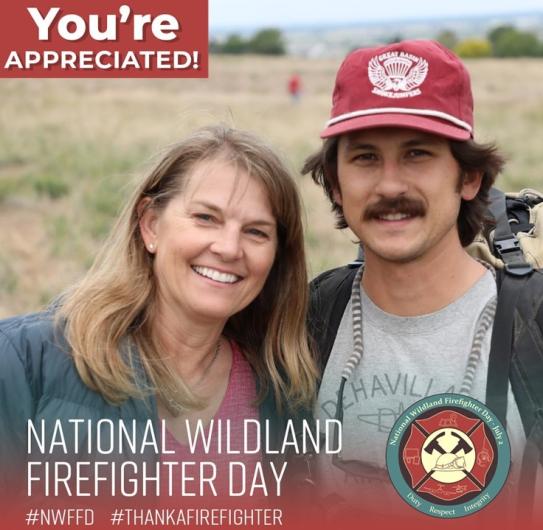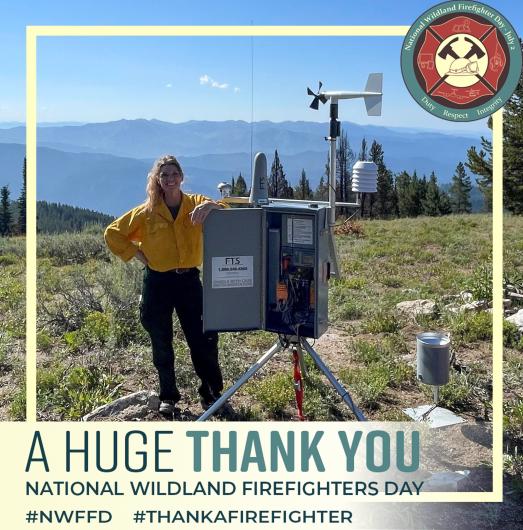Faces of wildland fire: meet Matt Fraga and Cindy Sherfick
With the approach of National Wildland Firefighter Day on July 2, we’re spotlighting some of the amazing people in the wildland fire community. Meet Matt Fraga, a crewmember of the Great Basin Smokejumpers, and Cindy Sherfick, an electronics technician for the Remote Automatic Weather Systems (RAWS) Depot, located at the National Interagency Fire Center (NIFC).

Smokejumpers are wildland firefighters who get to their job sites by jumping out of airplanes at 3,000 feet. These firefighters are assigned to fires in very remote country, usually ignited by lightning strikes, which engines cannot access and where hiking in is impractical. It’s a rapid form of response, meant to contain fires while they’re still small.
In his second season, Matt is a newer member of the crew. In 2018, he had just completed structural fire academy when he learned about the wildland side of fire and changed his career plans completely. He worked on a contract engine, a type 2 hand crew, and spent three years with the Dalton Hotshots on the Angeles National Forest before getting his chance to rookie with the Great Basin Smokejumpers in 2024. Smokejumper rookie training is notoriously grueling – an average of 45% of new recruits graduate to full-fledged smokejumper status.
“It was harder than I thought. Hard on your body, of course, but the big part for me was mental. You have to open up different parts of your brain to take in all kinds of information and then go out and apply it immediately. It’s the perfect world for a hands-on learner,” Matt says.
So, what is it like to jump for the first time? “Imagine the gnarliest rollercoaster you’ve ever been on…your breath is just gone,” Matt says. “But you focus on your jump count. Your parachute opens and you go right into everything that you learned on the ground. You’re steering. We jump in two- to four-person ‘sticks’, and the first person in the stick has to create vertical and horizontal space from their jump partner, which is hard physical work. There’s a lot happening on the descent.”
For Matt, being a smokejumper is an opportunity to explore and protect wild places and push himself while doing it. "It keeps you honest, keeps you fit. And it's the best way to get to work."

RAWS include both permanent and temporary structures that gather weather data across the U.S. and its territories, often in very remote areas. There are nearly 2,700 permanent RAWS stations across the U.S. in addition to portable stations that are set up temporarily (for example, during wildfires). The data that the stations collect help predict fire behavior and is crucial in fire management. The RAWS Depot services the weather stations and their components. Cindy preps and calibrates the weather sensors, ensuring that they meet national fire danger rating standards (NFDRS). The sensors are then sent back out into the field to be placed on stations.
As a young person, “I wanted to travel and have adventures,” Cindy says. “I wanted to work on forests, but I had no idea how to even start. Of course, this is all pre-Google.”
An Idaho native, Cindy was recruited by NIFC employees for the Student Career Experience Program (now the Pathways Program) in 1997, while attending ITT Technical Institute. The program provided professional experience throughout her education, assisting radio technicians in the field. Later, she got her introduction to RAWS as a field technician in Alaska, flying in helicopters to far-flung locations, and later was a tower climber in Colorado, building cell towers and rooftop masts.
Cindy’s husband served 10 years in the U.S. Air Force, during which they lived in Japan, Las Vegas and Hawaii. Their growing family finally returned to Boise, where Cindy returned to NIFC as an electronics technician contractor for the radio shop, and later for the RAWS Depot. She spent several years working at her children’s school, being present with her family. During that time, she took assignments on wildfires during the summers to stay current with her trainings. Finally, she returned to NIFC as a full-time RAWS technician in 2020.
“I’m thankful that it all has come back around. No time was wasted – and it all gave me perspective. I’ve had a lot of travels and experiences that I feel makes me more well-rounded as a depot technician and field technician. The perspective helps me see the things that will make it easier for others, like helping make it more of a team effort as we support our field crews going out,” she says.
“We’re united by mission in the fire community, the sense that your work matters. We are held accountable for the quality of our work. It is important,” Cindy says. “At the same time, we are not just numbers here. It definitely is something more than that.”
Rebecca Paterson, Public Affairs Specialist
Related Stories
- History of National Wildland Firefighter Day
- Faces of wildland fire: meet Joe Schindel and Steven Gaskill
- Uncrewed aircraft reduce cost, lower risk, and improve land management
- Faces of wildland fire: meet Logan Blankenship and Scott Mayer
- A peek inside second annual junior ranger day at local elementary school
